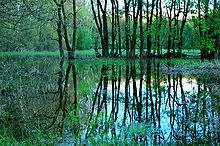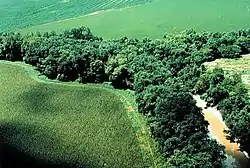Riparian forest
A riparian forest or riparian woodland is a forested or wooded area of land adjacent to a body of water such as a river, stream, pond, lake, marshland, estuary, canal, sink or reservoir.

Etymology

The term riparian comes from the Latin word ripa, 'river bank'; though, technically it only refers to areas adjacent to flowing bodies of water such as rivers, streams, sloughs, and estuaries. However, the terms riparian forest and riparian zone have come to include areas adjacent to non-flowing bodies of water such as ponds, lakes, playas and reservoirs.
Characteristics


Riparian forests are subject to frequent inundation.
Riparian forests help control sediment, reduce the damaging effects of flooding and aid in stabilizing stream banks.
Riparian zones are transition zones between an upland terrestrial environment and an aquatic environment. Organisms found in this zone are adapted to periodic flooding. Many not only tolerate it, but require it in order to maintain health and complete their lifestyles.[1]
Threats
Threats to riparian forest:
- Cleared for agriculture because of the good soil in riparian forest
- Woods are removed for steamships, railroads, etc.
- Urban development
- Grazing
- Mining
- Disrupted hydrology, such as dams and levees, which causes less flooding
- Invasive species
References
- Molles, M.C. Jr. (2008). Ecology: Concepts and Applications (4th ed.). New York: McGraw-Hill. p. 291. ISBN 0-07-330976-1.
External links
- "Assessing the Need for a Riparian Management System (RiMS)"—Iowa State University Extension Bulletin (2002)